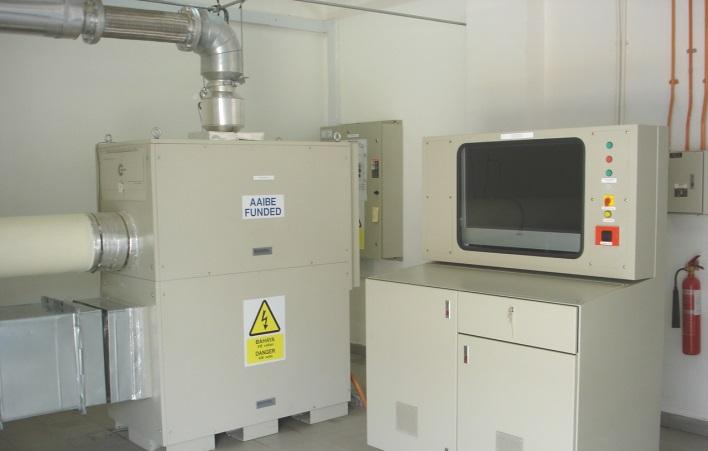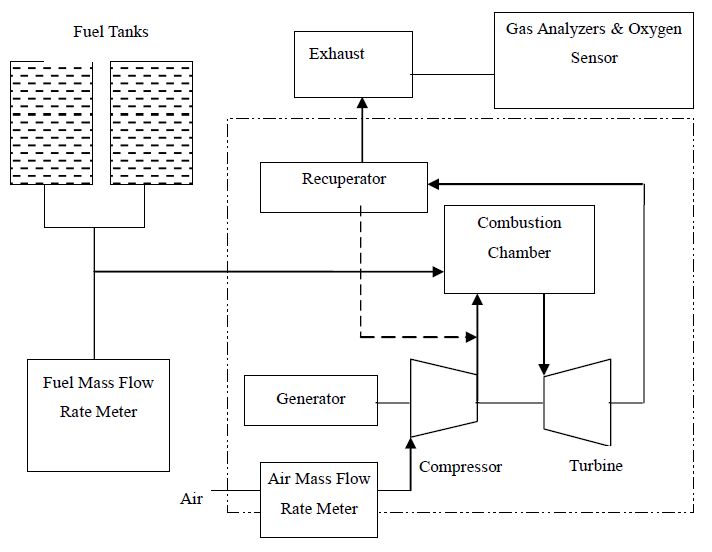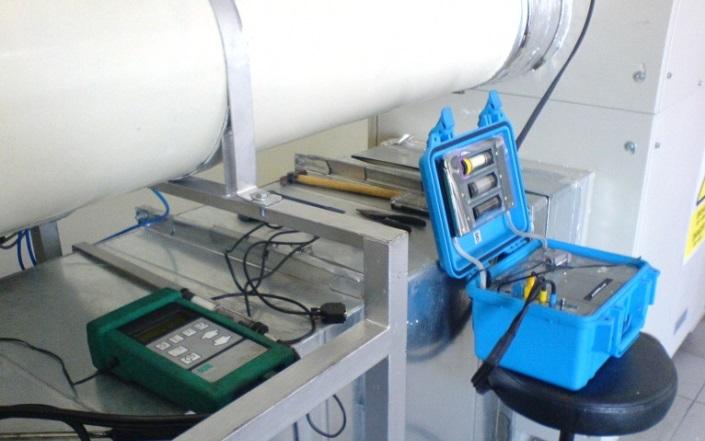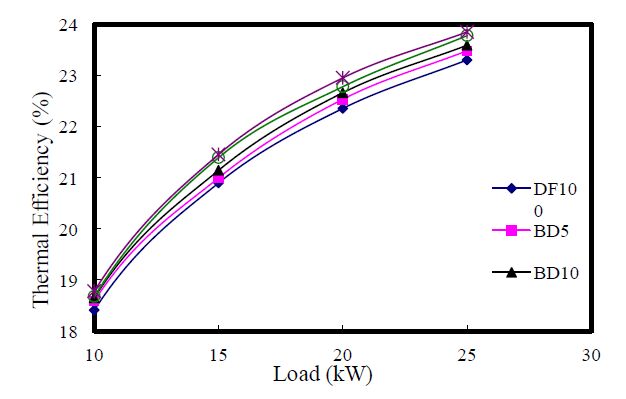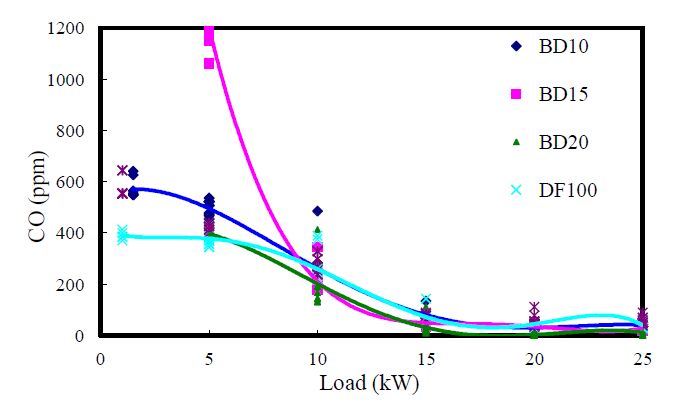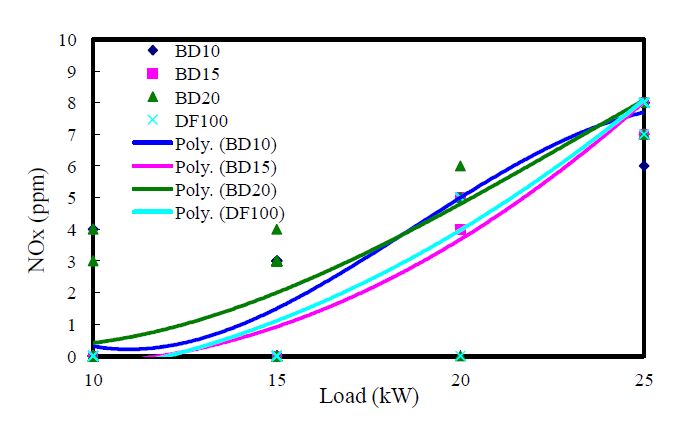1. Introduction
Fossil fuels have been the major energy resource of the world in the past century. However, the massive utilization of fossil fuels has depleted their reserves and raised the concern on the impact of hazardous exhaust gases to the environment. It is estimated that the oil reserves will be exhausted within 40 years if consumed at the current rate [1]. Therefore, there is a need to seek renewable and sustainable energy resources.
Among the many different energy forms, diesel fuel plays an important role in the industrial and economic growth of a country because it contributes to a major portion of the transportation and power generation sectors. On the other hand, major concerns on depletion of fossil fuels and negative impacts on the environment have called for the development and use of an alternative fuel to substitute diesel. Currently, one such fuel that can be substituted for diesel engine application is fatty acid methyl esters (FAME) or more commonly known as biodiesel. According to the American Society of Testing Methods (ASTM), biodiesel is defined as a domestic, renewable fuel derived from the transesterification of animal fats and vegetable oils. It also meets the standards of ASTM D6751 or its equivalent. Biodiesel derived from waste cooking oil (WCO) can be regarded as potential feedstock for biodiesel production because it is non-edible and it can convert waste to energy. Similarly, it possesses almost the same chemical properties to diesel and distillate fuel, which are used predominantly as secondary fuel in gas turbines.
The success of biodiesel application can be seen in the transportation sector, where biodiesel blends are used with diesel in countries like United States of America, Brazil, France, Germany, Italy and Malaysia. However, applying biodiesel into the internal combustion engines showed many problems associated with engine knocking, pour point temperature limitations in cold climate countries and long term wear and tear [2,3].
Biodiesel have proven that it can be burned effectively under high pressure intermittent combustion in reciprocating compression ignition diesel engines. This has prompted researchers to suggest that it can potentially be used as an additive fuel for gas turbines in power plants under a lower pressure continuous combustion in gas turbine [4]. The utilization of biodiesel in gas turbine applications may help to mitigate the environmental impact by using fossil fuels. This is because that the burning of fossil fuels for electricity and heat generation is the largest single source of global greenhouse gases, according to the United States Environmental Protection Agency [4]. It is advocated in this research study that partial fuel substitution of biodiesel in gas turbines could contribute significantly to environmental benefits. Another advantage of biodiesel usage is that it requires no modifications in existing gas turbine systems. For assessing the technical feasibility of biodiesel in gas turbine applications, this research focuses on the microturbine system, since it is a smaller unit, but having a similar thermodynamic system of conventional gas turbines while achieving a higher thermal efficiency with the addition of a recuperator. Other researchers have concentrated on the utilization of biodiesel in internal combustion engines, while microturbines are known for its lower exhaust emissions, which is the key advantage for decentralized power generation.
There is limited research publications on the utilization of biodiesel in microturbine systems, and most concentrated on the first generation biodiesel. Several studies used raw vegetable oil and their blends with diesel in a microturbine unit [5,6,7]. Meanwhile, other researches [8,9] focused mainly on methyl esters produced from various feedstocks. Second generation biodiesel are non-edible and therefore is much more sustainable for long term use, as in our case biodiesel derived from palm oil based WCO was used. There are many feedstocks used in the production of biodiesel, but the most challenging would to be the waste cooking oil. Compared to feedstocks derived from direct plant oil, such as sunflower oil, canola oil, rapeseed oil, and corn oil. The main challenge of using WCO is due to the high content of free fatty acid (FFA) within the raw material which can cause complication in the transesterification process. When applying biodiesel derived from WCO which contains high free fatty acid (FFA), it is crucial that the physical and chemical properties shall meet the microturbine system requirements, thus minimizing the system modification.
The technical feasibility of biodiesel utilization in microturbines must be addressed before biodiesel can be used commercially. The main focus of this study is to investgate interactions between specific fuel properties, and their impact on the microturbine performance and exhaust emissions. Studies on the combustion behaviour and the heat transfer characteristics are significant considerations in evaluating the feasibility of any potential fuel in gas turbine applications. Therefore, this research aims to address the performance and emission test of biodiesel in a microturbine, using biodiesel derived from WCO and its blend with distillate to generate electrical power.
2. Materials and Method
2.1. Biodiesel production
Biodiesel is normally produced by the transesterification of raw materials like vegetable oils, animal fats and WCO. For this research, the raw material used was WCO which was based on palm oils. An alkali catalyst was selected among various kinds of catalysts due to its lower cost and quicker reaction time. In the transesterification process, sodium hydroxide (NaOH) and methanol were mixed to produce sodium methoxide (Na+CH3O−). By mixing it with WCO, this strong polar-bonded chemical breaks triglyceride acid into glycerin and ester chains (biodiesel). Glycerin sank to the bottom and biodiesel floated on the top layer due to the difference in the density.
WCO biodiesel was produced using a five liter lab-scale processor shown in Figure 1. The processor is able to produce biodiesel with the qualities that consistently meet ASTM D6751 standards. Furthermore, other features are incorporated into the processor to ensure that the fuel produced also meets ASTM D2880 standards. Various fuel samples were tested periodically throughout the duration of the study and the property test results showed that it meets both ASTM standard requirements within the range allowable.
2.2. Microturbine performance & emission test
The performance and emission test was conducted in a 30 kW microturbine using five types of fuel, namely pure distillate, B5, B10, B15, and B20. The number behind the notation “B” stands for the percentage of biodiesel mixed with distillate. The reason for the fuel sample not exceeding the 20% biodiesel mixing ratio is due to most research studies [3] showing that 20% biodiesel blend achieves the highest efficiency. Besides, there exist constraints in testing biodiesel beyond this biodiesel mixing ratio due to manufacturer’s warranty. This is important to study effects of biodiesel on the operational hardware of the microturbine fuel systems.
A 30 kW liquid fuel microturbine, did not require modifications and changes to the existing system for its operation using WCO biodiesel and distillate blends. The equipment depicted in Figure 2 is placed in the Gas Turbine Technology Laboratory in Uniten. The microturbine employs the open cycle regenerative Brayton cycle.
Figure 3 shows the schematic diagram of the microturbine system installed. A pump is placed on the fuel tank to channel the fuel into the combustion chamber. There is a mass flow meter attached to the fuel tanks to obtain data for the mass flow rate. The real-time data are available for the fuel flow, the combustion efficiency, the temperatures, the pressures, the high heating value or the calorific value, the combustion efficiency, the generated power output, the speed and the torque. These parameters are logged in via the data acquisition system.
2.3. Performance test method
The performance test was conducted at an ambient temperature of 23.9 °C to 24.2 °C. Because the power output of microturbine is affected by the ambient temperature, in view of Malaysia’s tropical climate, it was recommended to conduct the test at a lowest ambient temperature in order to achieve the highest power output. The microturbine had been calibrated in accordance with the manufacturer’s correction curves during the commissioning prior to the testing. The microturbine was started using diesel for 30 minutes, to warm up the equipment, before switching to designated test fuel once it has reached the steady-state condition. This steady-state condition was achieved when the temperature of the exhaust gas, the mass flow rate of the fuel and the electric power output reached stable readings. It took approximately 20 minutes at full load to reach the steady state condition with a new test fuel. Then, the power output was varied from idle to 25 kW with an interval of 5 kW, whilst ensuring that steady state conditions were reached before measurements were started. After completion of the performance test, the test fuel was switched back to diesel, enabling it to run for a certain period of time to ensure that there was no test fuel left in any part of the microturbine fuel system. The procedure was repeated for all five samples of fuel—distillate, B5, B10, B15 and B20.
2.4. Emission test method
Two portable gas analyzers and an oxygen sensor were placed near the exhaust stack of the microturbine for emission monitoring. The emission data of the exhaust gas such as CO, CO2, O2, SO2 and NOx were recorded at one minute interval. One of the gas analyzers were connected to the primary stages of the microturbine exhaust, whereas the other was connected about 3 meters away from the first gas analyzer’s probe. Figure 4 shows the gas analyzer connection to the microturbine system during the performance test.
3. Results and Discussion
3.1. Properties test analysis
Both the physical properties and chemical properties are important aspects in determining the characteristics of fuels. Table 1 shows the critical fuel properties.
Table 1. Chemical fuel properties of distillate, B20, B15, B10, and B5.
| Properties | Standards | BD20 | BD15 | BD10 | BD 5 | Distillate |
| Water & Sediment (%vol) | ASTM D 1796 | 0.0700 | 0.0525 | 0.0350 | 0.0175 | - |
| Viscosity (mm2/sec) | ASTM D 445 | 4.712 | 4.709 | 4.706 | 4.703 | 4.700 |
| Calorific Value (kJ/kg) | ASTM D 3286-96 | 43,480 | 43,810 | 44,140 | 44,470 | 44,800 |
| Sulfur Content (%wt) | ASTM D 4294 | 0.112 | 0.119 | 0.126 | 0.133 | 0.140 |
| Carbon (%wt) | ASTM D 5291 | 83.30 | 83.88 | 84.40 | 84.90 | 85.38 |
| Hydrogen (%wt) | ASTM D 5291 | 13.16 | 13.20 | 13.21 | 13.25 | 13.27 |
| Oxygen (%wt) | STM D 5291 | 3.42 | 2.80 | 2.26 | 1.72 | 1.21 |
| Nitrogen (%wt) | ASTM D 5291 | 0.12 | 0.12 | 0.13 | 0.13 | 0.14 |
| Ash Content (%wt) | ASTM D 482 | 0.017 | 0.018 | 0.019 | 0.02 | 0.021 |
| Sodium (mg/kg) | ICP-OES | 0.624 | 0.613 | 0.602 | 0.591 | 0.58 |
3.2. Microturbine performance test results
The output and the efficiency of gas turbines are highly affected by the ambient temperature and humidity, while the gas turbine performance has been improved considerably in recent years due to the rapid development of component design and material technologies [10].
The simplest remedy to enhance the performance is to reduce the gas turbine inlet air temperature, for which several methods have been suggested in the past, based on absorption chillers, evaporation coolers and fog cooling. Power augmentation in a gas turbine based generator is achieved by the external supply of preheated and pressurized humidified air into the upstream of the gas turbine combustor. This can increase the mass flow of the gas flowing into the turbine and boost the net power output of the unit. The incremental power from air injection is proportional to the mass of the injected flow. Since the mass flow is added at a high pressure point of the cycle, the work of the gas turbine’s axial flow compressor is virtually unchanged. Better combustion also implies more energy available to produce turbine work output of which the same amount of compressor work is consumed, increasing the net work.
The experimental data was recorded beginning at 5 kW, however the graphs plotted in Figures 5 to Figure 7 begin at 10 kW. The performance at 5 kW was low, thus the data were omitted to enable emphasis on the performance in the range of 10 kW to 25 kW. Based on a study by the California Energy Commission, microturbine generators generally responded more slowly at load set points lower than 10 kW [11]. This was a result of the rough operation of the unit at these lower load set points and unstable operation of the generator at power levels below 10 kW.
Meanwhile, Figure 5 shows the thermal efficiency versus the load obtained by Equation 1. The thermal efficiency lies within the range of 18-24 %. It can be noted that the thermal efficiency of biodiesel blends surpasses that of pure distillate. This is because biodiesel is an oxygenated fuel, having more oxygen content in the fuel compared to distillate, thus aiding to complete the combustion process. The elemental analysis showed in Table 1, observes the oxygen content of B20, which is approximately three times more than distillate. Therefore, this shows that biodiesel, which has a lower calorific value compared to distillate, may not necessarily have a negative consequence on the performance of the microturbine. The thermal efficiencies of a B20 were slightly higher compared to normal distillate, thought to be a result of the oxygenation of the fuel. This claim has agreed with the findings by other researcher [12].
where Wnet = generator power; HI = Heat Input which is calculated using Equation 2 below.
where Ql = volumetric flow; ρl = density of the liquid fuel at operating temperature, LHVp = lower heating value at constant pressure, SHp = sensible heat at constant pressure.
Interestingly, this means that B20, having the lower heating value of 43,480 kJ/kg compared to distillate with 44,800 kJ/kg, was able to sustain better thermal efficiency. Although it is merely 3 % difference between the two numbers, it is sufficient to cause an increase in the net combustion efficiency for biodiesel blended fuel, compensating the lower heat of combustion due to the non-hydrocarbon features of biodiesel. The differences would be most noticed at low rpm and high engine load when the engine would most benefit from more oxygen [4].
3.3. Microturbine emission test results
Two gasses, namely carbon dioxide (CO) and nitrogen oxide (NOx) were monitored for their emission during the microturbine operation. The graph of CO concentration and NOx concentration are plotted against the load for each specified test fuel as shown in Figure 6 and Figure 7 respectively. The emission tests were recorded from 0 kW-25 kW, however the results for loading between 10-25kW will be emphasized because these loads achieved a more stable reading. As for SOx, no emissions for biodiesel fuel were found in the exhaust gases, because there is no sulfur in the biodiesel composition. This is an obvious environmental benefit of blending biodiesel with high sulfur diesel/distillate.
The results for the microturbine emission test shown in Figure 6 shows that generally the CO concentration decreases when the load increases from 10-25 kW. In addition, the peak CO concentration varies for different load levels. For example, at 5 kW, the highest CO level was recorded at BD15, while at 15 kW; the highest CO emission was obtained at distillate. The difference in the results could be affected by the operating pressure and combustion dynamics in the microturbine generator. However, the results trend agrees with other researchers [13,14,15]. The results obtained from Figure 6 have similar increasing trend in which CO levels decrease sharply as the microturbine runs on higher loads. The use of biodiesel has significantly helped reduce CO emission, particularly at lower loads. When the load increases higher, the difference between the CO emission of distillate and biodiesel narrowed down. This is because the combustion becomes more complete as higher loads are executed on the microturbine. Typically, as fuel input and power output are increased, the combustion temperature increases, enabling the oxidation of CO produced in the combustion. Therefore, the CO levels are lower at higher power outputs. However, it does seem that the emission of those with biodiesel blends is significantly better, that is less CO concentration emitted, particularly at higher power outputs.
The emission of NOx is a significant concern for power producers. In the use of biodiesel blends in diesel engines, this has been cause for some concern as it has been often observed that NOx tends to increase in most studies [16,17]. However, in small boilers, it has been observed that the addition of biodiesel to heating oil tends to lower the NOx emission. For the microturbine emission test, the NOx concentration is highest at B20 as shown in Figure 7. This could be due to the effect of thermal NOx being the highest at B20 because the thermal efficiency is highest at this stage, thus the extreme exhaust temperatures results in excessive production of thermal NOx. This statement can be substantiated with the temperature results obtained from the exhaust as shown in Table 2. From this data, the highest exhaust temperature is recorded at 20 kW, using B20 which coincidently, has the highest thermal efficiency at this point. The temperature difference is insignificantly small, because the fuel ranges with small increment of 5% for each blend.
Table 2. Highest exhaust temperature data.
| Fuel type | Temperature (Celcius) |
| D100 | 772.07 |
| B5 | 772.59 |
| B10 | 772.69 |
| B15 | 773.90 |
| B20 | 774.66 |
Thermal NOx formation is controlled largely by the flame temperature, inlet air temperature and the residence time. In the context of flame temperature, the highest flame temperature should be the adiabatic flame temperature which occurs at stoichiometric condition. However, emission of NOx tends to increase at fuel-lean conditions and decreases at fuel-rich conditions. This is a consequence of the competition between fuel and nitrogen for the available O2 levels. Although the combustion temperature is higher on the slightly rich side of stoichiometric, the available O2 is consumed preferentially by the fuel. As NOx emissions are dependent on flame temperature, an increase in inlet air temperature would be expected to produce a significant increase in NOx emissions. Meanwhile, NOx emissions increase with an increase in residence time, except for very lean mixtures. This trend is portrayed in all the test fuel, with B20 recording the highest NOx compared to the other test fuels. The biodiesel fuel has limited nitrogen content in its composition, almost 10% less than distillate fuel, as shown in Table 1. Therefore, most of the NOx emission comes from the thermal NOx. Theoretically, the production of NOx is strongly associated with the combustion chamber temperature. At lower power outputs, that is from 10-20 kW, the NOx levels are higher with the increase of biodiesel. At the higher power outputs of 20-25 kW, the NOx emitted seems to be about the same compared to all the five fuel samples. The NOx emission level for microturbine emission is significantly lower compared to emission levels of internal combustion engine. This is seen as an advantage for the power generation industry, where high amount of NOx emissions pose as an environmental threat from the burning of fuel. NOx emissions are coming from the thermal fixation of nitrogen and oxygen in the inlet combustion air and from the chemically-bound nitrogen conversion in the fuel. The fuel that has a higher efficiency will normally emit the highest NOx emissions as it has the highest flame temperature. In this case, since B20 obtained the highest thermal efficiency, the NOx emission is also highest at this point.
The emission results for CO and NOx are influenced by the combustor inlet temperatures, the combustion pressure and the primary-zone equivalence ratio and the mean drop size of the spray. From the property comparison evaluation, the combustion characteristics of the fuel rely on density and viscosity of the liquid fuel. Due to its higher viscosity, biodiesel has a comparatively higher droplet size compared to distillate. The equivalence ratio might be different for each type of fuel and these factors could influence the CO and NOx emission levels.
4. Conclusion
The physical and chemical fuel properties of biodiesel have a linear correlation with percentage of biodiesel blends with diesel/distillate. A full properties test was conducted for five types of biodiesel and diesel blends, namely B5, B10, B15 and B20 for the microturbine performance and emission test. Although moisture content for neat biodiesel is higher compared to standard specifications, it can be reduced by a heating process. High moisture content contributes to a high value of density which will generally improve atomization injection properties [18].
This paper has proven that microturbine is able to operate on biodiesel derived from WCO. The microturbine performance and emission test showed that data were not stable at loads below 10kW. Thermal efficiency increase as percentage of biodiesel in the blend increased despite biodiesel having low calorific value and a slightly higher fuel consumption. The sample with biodiesel blends also outperforms neat distillate in terms of efficiency. Generally, the efficiency increases as load increases from 5-25 kW. The finding from this study shows promising potential for the application of biodiesel as substitute for microturbine liquid fuel, in line with existing power augmentation works, which is to achieve an increase in efficiency.
Meanwhile, microturbine emission test showed that the CO concentration decreased as the load increased, but it is difficult to ascertain which fuel sample has the highest CO value because the variation of CO peaks at different loads due to differences in operating conditions. Sulfur oxides (SOx) are observed to be negligible due to insignificant amount of sulfur present in the fuel. In addition, the lubricity of the fuel is guaranteed although there is limited amount of sulfur in biodiesel because biodiesel has its own natural lubrication characteristics. Nitrogen oxides (NOx) have been reported to be highest at BD20 where the efficiency is highest in the microturbine emission test. This is because a major portion of NOx is contributed by thermal NOx, caused by the high exhaust temperatures at combustor outlet
Acknowledgments
The authors would like to thank the Ministry of Science, Technology and Innovation, Malaysia and the Ministry of Education, Malaysia for providing the funds to conduct this research. The Japan Society for Promotion of Science (JSPS) contribution in the collaboration between both universities is greatly appreciated.
Conflict of interest
All authors declare no conflicts of interest in this paper.









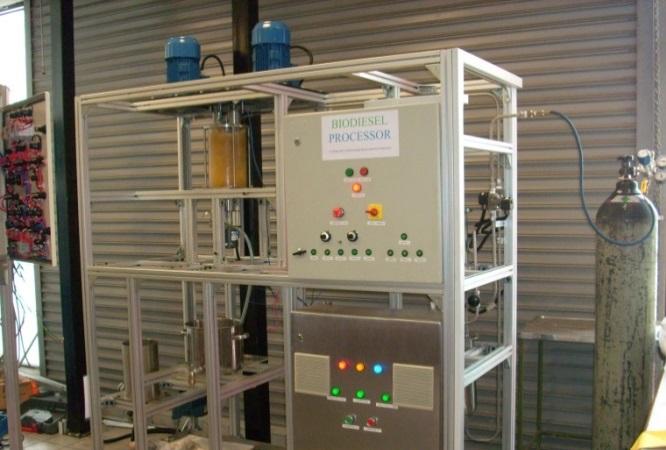
 DownLoad:
DownLoad: 